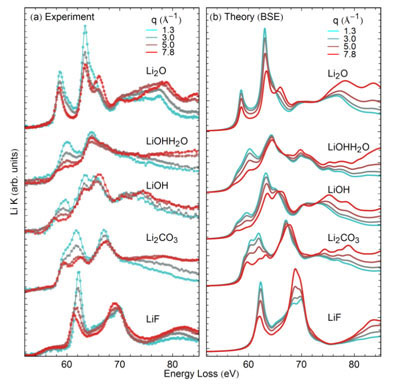A New Tool to Probe the Inner Workings of Rechargeable Batteries
A new spectroscopic “fingerprinting” technique has been developed at a DOE user facility to identify chemical degradation products deep inside a working rechargeable battery.

The Science
Spectroscopic fingerprints for a suite of possible degradation products at the solid-electrolyte interface (SEI) of lithium ion batteries were developed using theoretically validated measurements of lithium and oxygen in pure, bulk materials.
The Impact
Powerful in-situ characterization and identification of degradation products formed inside operating lithium ion batteries will provide insights on how to make batteries better. The technique is now available to the open research community at a DOE user facility.
Summary
Understanding what happens inside of rechargeable batteries is critical to making them safer and last longer. For commercially important lithium-based batteries, a new tool has been developed that uses high resolution lithium and oxygen spectroscopy to study the degradation products formed in a working battery. Inelastic x-ray scattering (IXS) measures and analyzes the energy lost by x-rays when they are scattered by light elements such as lithium; the resulting spectrum is very sensitive to the bonding and chemical structure of the atoms in the material being analyzed. Unlike traditional spectroscopic probes, IXS uses high energy x-rays that can penetrate deep inside a working battery – assessing the elemental changes at the critical solid-electrolyte interface(SEI) inside the battery. Work at Argonne National Laboratory supported by the Center for Electrical Energy Storage, a DOE Energy Research Frontier Center, is using lithium and oxygen spectra of pure, known compounds to create a catalogue of spectroscopic fingerprints of the possible decomposition productions in lithium-ion batteries. Theoretical calculations agree with the measured spectra of pure compounds, providing validation that the IXS spectra can be used to probe an unknown mixture of SEI products. Ongoing studies will use the fingerprints to determine the composition of the SEI and to decouple decomposition reactions from actual discharge products for a Li-air battery. This technique is now available to the broader battery research community at Argonne’s Advanced Photon Source.
Contact
Tim T. Fister
Argonne National Laboratory
fister@anl.gov
Mahalingam Balasubramanian
Advanced Photon Source
mali@aps.anl.gov
Michael Thackeray
Director of the Center for Electrical Energy Storage (CEES)
thackeray@anl.gov
Funding
DOE Office of Science, Office of Basic Energy Sciences, Energy Frontier Research Centers (EFRC) Program; Part of the research was performed at DOE Basic Energy Sciences user facilities: Advanced Photon Source (APS) and Center for Nanoscale Materials. The APS beamline has partial support from the Natural Sciences and Engineering Research Council of Canada.
Publications
Fister, T.T. Schmidt, Moritz; Johnson, ChristopherS.; Slater, MichaelD.; Shirley, Eric L. ; Chan, MariaK. Y.; and Fenter, Paul “Electronic structures of lithium battery interphase compounds: comparison between inelastic x-ray scattering measurements and theory” J. Chem. Phys., 135, 224513 (2011). [DOI: 10.1063/1.3664620];
Chan, MariaK. Y.; Shirley, Eric L.; Karan, NabaK; Balasubramanian, M.; Greeley, JeffreyP; and Fister, T.T. “Structure of lithium peroxide” J. Phys. Chem. Lett., 2, 2483–2486 (2011). [DOI: 10.1021/jz201072b]
Related Links
Center for Electrical Energy Storage (CEES) EFRC
Center for Nanoscale Materials
Highlight Categories
Performer: DOE Laboratory , SC User Facilities , BES User Facilities , APS , CNM



